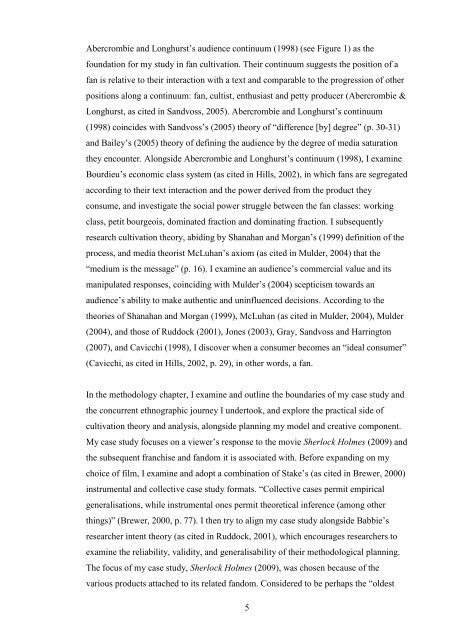The Case Study of Sherlock Holmes (2009) - Scholarly Commons ...
The Case Study of Sherlock Holmes (2009) - Scholarly Commons ...
The Case Study of Sherlock Holmes (2009) - Scholarly Commons ...
You also want an ePaper? Increase the reach of your titles
YUMPU automatically turns print PDFs into web optimized ePapers that Google loves.
Abercrombie and Longhurst‟s audience continuum (1998) (see Figure 1) as the<br />
foundation for my study in fan cultivation. <strong>The</strong>ir continuum suggests the position <strong>of</strong> a<br />
fan is relative to their interaction with a text and comparable to the progression <strong>of</strong> other<br />
positions along a continuum: fan, cultist, enthusiast and petty producer (Abercrombie &<br />
Longhurst, as cited in Sandvoss, 2005). Abercrombie and Longhurst‟s continuum<br />
(1998) coincides with Sandvoss‟s (2005) theory <strong>of</strong> “difference [by] degree” (p. 30-31)<br />
and Bailey‟s (2005) theory <strong>of</strong> defining the audience by the degree <strong>of</strong> media saturation<br />
they encounter. Alongside Abercrombie and Longhurst‟s continuum (1998), I examine<br />
Bourdieu‟s economic class system (as cited in Hills, 2002), in which fans are segregated<br />
according to their text interaction and the power derived from the product they<br />
consume, and investigate the social power struggle between the fan classes: working<br />
class, petit bourgeois, dominated fraction and dominating fraction. I subsequently<br />
research cultivation theory, abiding by Shanahan and Morgan‟s (1999) definition <strong>of</strong> the<br />
process, and media theorist McLuhan‟s axiom (as cited in Mulder, 2004) that the<br />
“medium is the message” (p. 16). I examine an audience‟s commercial value and its<br />
manipulated responses, coinciding with Mulder‟s (2004) scepticism towards an<br />
audience‟s ability to make authentic and uninfluenced decisions. According to the<br />
theories <strong>of</strong> Shanahan and Morgan (1999), McLuhan (as cited in Mulder, 2004), Mulder<br />
(2004), and those <strong>of</strong> Ruddock (2001), Jones (2003), Gray, Sandvoss and Harrington<br />
(2007), and Cavicchi (1998), I discover when a consumer becomes an “ideal consumer”<br />
(Cavicchi, as cited in Hills, 2002, p. 29), in other words, a fan.<br />
In the methodology chapter, I examine and outline the boundaries <strong>of</strong> my case study and<br />
the concurrent ethnographic journey I undertook, and explore the practical side <strong>of</strong><br />
cultivation theory and analysis, alongside planning my model and creative component.<br />
My case study focuses on a viewer‟s response to the movie <strong>Sherlock</strong> <strong>Holmes</strong> (<strong>2009</strong>) and<br />
the subsequent franchise and fandom it is associated with. Before expanding on my<br />
choice <strong>of</strong> film, I examine and adopt a combination <strong>of</strong> Stake‟s (as cited in Brewer, 2000)<br />
instrumental and collective case study formats. “Collective cases permit empirical<br />
generalisations, while instrumental ones permit theoretical inference (among other<br />
things)” (Brewer, 2000, p. 77). I then try to align my case study alongside Babbie‟s<br />
researcher intent theory (as cited in Ruddock, 2001), which encourages researchers to<br />
examine the reliability, validity, and generalisability <strong>of</strong> their methodological planning.<br />
<strong>The</strong> focus <strong>of</strong> my case study, <strong>Sherlock</strong> <strong>Holmes</strong> (<strong>2009</strong>), was chosen because <strong>of</strong> the<br />
various products attached to its related fandom. Considered to be perhaps the “oldest<br />
5

















